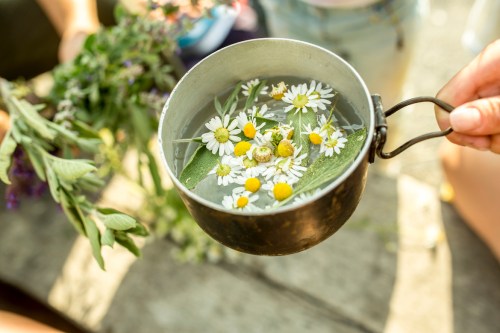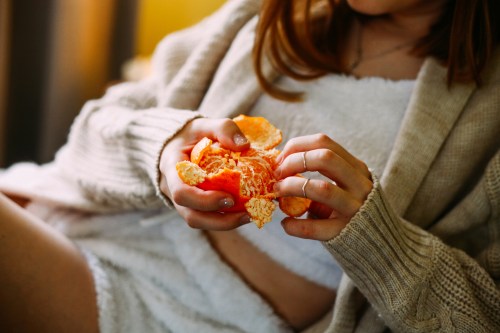Our editors independently select these products. Making a purchase through our links may earn Well+Good a commission
I’m willing to bet that if you’re someone who finds the plant life super soothing, you also love cuddling up with a cup of chamomile at the end of the day. Both are all about that reverence for botanicals, domestic comforts, and not feeling so stressed all the time. So why not enjoy both? Nurturing your own ingredients for tea isn’t just an objectively adorable flex, it’s a long-term practical move. All you need to do is know what to grow in your tea garden.
Experts in This Article
horticulturalist for Earth’s Ally.
Even if you’re a connoisseur of all the best brews, not every plant makes something viable. Thankfully, Earth’s Ally master gardener and horticulture expert Angelo Randaci has some insight into what really steeps. Since you’re responsible for straining your own mix, it could be worth it getting a Reusable Tea Strainer Bags ($11), a cute tea strainer like this Gold Heart Shaped Tea Strainer ($5), and even an an Hourglass Tea Ritual Set ($60) if you’re fancy.
This is what to grow in your tea garden, according to a gardener
1. Elderberry (Sambucus nigra)
Elderberry is one of the easiest and most versatile shrubs to grow in a tea garden. For the best fruit production, try to plant at least two different varieties together, says Randaci.
“They grow well in either full or part sunny locations and make a perfect backdrop for your shorter tea garden plants,” he says. “The newer available varieties have highly ornamental characteristics such as purple or green and white variegated foliage. They thrive in soils with plenty of moisture and even wet areas of your garden.”
To brew the tea, you’ll want to use dried, ripe elderberries that have been boiled in water. And prepare to harvest some botanical benefits. “The berries are rich in highly bioactive antioxidants which support the immune system,” says Randaci. “They could help soothe inflammation, lessen stress, and help protect your heart.”
2. Peppermint (Mentha piperita)
“Of all the herbal teas, peppermint tea is the most consumed throughout the world,” says Randaci. “Peppermint oil from the leaves contain high amounts of menthol which give the tea its strong, sharp, minty and cooling taste. Peppermint tea is said to be good for increasing alertness, enhancing mood, improving memory, helping people sleep, improving bad breath, boosting the immune system, and helping with symptoms of a common cold.”
As for maintenance, he tells us to make sure the plant minds its space and gets lots of light. “Mints are vigorous perennials that prefer moist but well-drained sites in full to partial sunny conditions,” says Randaci. “Peppermint plants have a running habit, and will quickly take over an area if not managed by a containment of some sort.
3. Lavender (Lavandula angustifolia)
“Lavender tea is made from flower buds that grow on long, upright, purple flower spikes,” says Randaci. “Drinking lavender tea may improve your mood and have a general calming effect. It may also improve sleep quality and skin health. In the tea garden, lavender performs as a reliable perennial in zones 5 through 9 if grown in well-draining soil in full sun.”
Lavender is known as “the plant for peace,” according to an herbalist:
4. German Chamomile (Matricaria recutita) and Roman Chamomile (Matricaria nobile)
Classic chamomile tea is made from dried flowers of either species, and as Randaci points out, it’s long been used as a traditional folk remedy for a wide range of health issues. Particularly it tends to be a tea-of-choice when it comes to winding down.
“German chamomile is an annual and must be planted every year,” says Randaci. It grows one to two feet in most any type of soil that is well-drained. Roman chamomile, on the other hand, is a perennial hardy in zones 4-9. This low growing chamomile will look its best when grown between flagstones or along pathways.”
5. Rose Petal/Rose Hip Tea
Timelessly beautiful roses can definitely be the centerpiece of a tea garden. Randaci suggest selecting varieties of roses for flower fragrance and large rose hips.
“Harvested buds, petals, and hips add a tasty floral fragrance and tangy flavor when added either alone or with other loose tea combinations,” says Randaci.
Note: Do not use or eat flowers from nurseries, florists, or garden centers. The pesticides used may not be labeled for food crops. Treat your garden roses with an organic repellent and disease spray for best results.
6. Holy Basil (Ocimum tenuiflorum)
Holy basil has is another member of the mint family that’s closely related to culinary basil. Clearly, though, it has a powerful reputation and major medicinal properties. Randaci tells me that Holy Basil is described as ‘The Incomparable One,’ ‘Elixir of Life,’ and ‘Queen of the Herbs.’
“Holy Basil has been used for centuries to cure symptoms of many diseases and ailments; asthma, bronchitis, colds, congestion, coughs and flu,” says Randaci. “It is said to promote a healthy response to stress, promote longevity, and nourish the mind. Inhaling the steam from a fresh cup of tea may help clear sinuses.”
7. Spearmint (Mentha spicata)
My YiaYia actually used to brew spearmint tea from bushels in our backyard, so I can vouch for the flavor. It’s lovely if you want something refreshing but a little less intense.
“Because spearmint contains less menthol than peppermint, it tends to be sweeter and milder with many of the same benefits of peppermint,” says Randaci. “Spearmint also has a running habit and is best contained and managed in the garden.”
8. Bee Balm (Monarda didyma)
“It’s believed that after the English tea was destroyed during the Boston Tea Party revolution, Bee Balm was used as a substitute tea,” says Randaci. “Because of its high thymol content—a strong antiseptic also found in thyme—bee balm is traditionally used for a variety of ailments including colds, flu, upper respiratory problems, fevers, and used topically for wounds. The species Monarda didyma is a beautiful garden perennial that attracts bees, hence the name, as well as other pollinators.”
Here’s how to make a nettle tea for natural allergy relief:
Oh hi! You look like someone who loves free workouts, discounts for cult-fave wellness brands, and exclusive Well+Good content. Sign up for Well+, our online community of wellness insiders, and unlock your rewards instantly.
Sign Up for Our Daily Newsletter
Get all the latest in wellness, trends, food, fitness, beauty, and more delivered right to your inbox.
Got it, you've been added to our email list.











